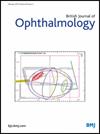迟发性视网膜母细胞瘤的临床危险因素增加和无白斑:一项比较队列研究
IF 3.5
2区 医学
Q1 OPHTHALMOLOGY
引用次数: 0
摘要
目的比较迟发性视网膜母细胞瘤(LoRB)(≥5年)与经典发病病例(<5年)的临床病理特征、治疗结果和预后因素。方法回顾性队列研究包括2016年4月至2023年12月在两个三级视网膜母细胞瘤(RB)中心诊断的21例LoRB和84例匹配的经典发病病例。收集并分析两组患者的临床表现、组织病理学特征、治疗方式和结果。根据晚发组的症状进行亚组分析。结果研究期间诊断为LoRB的患者21例,占全部RB病例的5.43%。诊断时的中位年龄为80个月。所有迟发性病例均为单侧表现,均属于国际眼内视网膜母细胞瘤分类D组和e组。与对照组相比,迟发性患者的诊断滞后时间明显延长(p=0.008),以白斑为首发症状的比例明显降低(p<0.001),玻璃体植入(p=0.03)和视网膜下积液(p=0.04)的比例较高,中位球保留时间较短(p=0.04)。与典型症状(白光眼和斜视)患者相比,迟发性非典型症状患者的诊断滞后时间更长(p=0.05),诊断时E组眼较多(p=0.03),中位球抢救时间更短(p=0.05)。结论LoRB临床特点明显,表现较为严重,应及早认识并及时干预。我们的研究结果有助于更全面地理解发病年龄和RB行为之间的关系。如有合理要求,可提供资料。本文章由计算机程序翻译,如有差异,请以英文原文为准。
Increased clinical risk factors and absence of leucocoria in late-onset retinoblastoma: a comparative cohort study
Aims To characterise the clinicopathological features, treatment outcomes and prognostic factors in late-onset retinoblastoma (LoRB) (≥5 years) compared to classical-onset cases (<5 years). Methods This retrospective cohort study included 21 cases of LoRB and 84 matched classical-onset cases diagnosed between April 2016 and December 2023 at two tertiary retinoblastoma (RB) centres. Data on clinical presentations, histopathological features, treatment modalities and outcomes were collected and analysed between two groups. A subgroup analysis was performed based on presenting symptoms in the late-onset group. Results During the study period, 21 patients with LoRB were diagnosed, accounting for 5.43% of all RB cases. The median age at diagnosis was 80 months. All late-onset cases presented unilaterally and were in International Intraocular Retinoblastoma Classification groups D and E. Compared with the control group, late-onset patients demonstrated significantly longer diagnostic lag times (p=0.008), a markedly lower rate of leucocoria as the presenting symptom (p<0.001), a higher rate of vitreous seeding (p=0.03) and subretinal fluid (p=0.04), and shorter median globe salvage times (p=0.04). Late-onset patients with atypical onset symptoms experienced longer diagnostic lag times (p=0.05), more group E eyes at diagnosis (p=0.03) and shorter median globe salvage times (p=0.05) compared with those with classical symptoms (leucocoria and strabismus). Conclusion LoRB presents distinct clinical features and more severe manifestations, highlighting the necessity for early recognition and timely intervention of this subtype. Our findings contribute to a more comprehensive understanding of the relationship between the age of onset and RB behaviour. Data are available upon reasonable request.
求助全文
通过发布文献求助,成功后即可免费获取论文全文。
去求助
来源期刊
CiteScore
10.30
自引率
2.40%
发文量
213
审稿时长
3-6 weeks
期刊介绍:
The British Journal of Ophthalmology (BJO) is an international peer-reviewed journal for ophthalmologists and visual science specialists. BJO publishes clinical investigations, clinical observations, and clinically relevant laboratory investigations related to ophthalmology. It also provides major reviews and also publishes manuscripts covering regional issues in a global context.

 求助内容:
求助内容: 应助结果提醒方式:
应助结果提醒方式:


